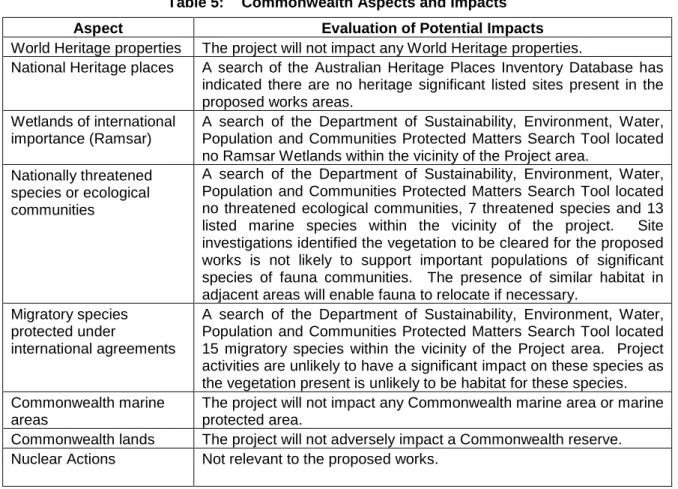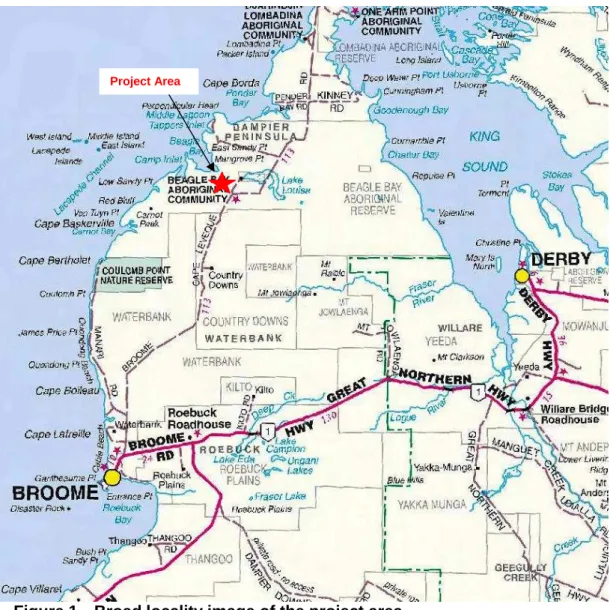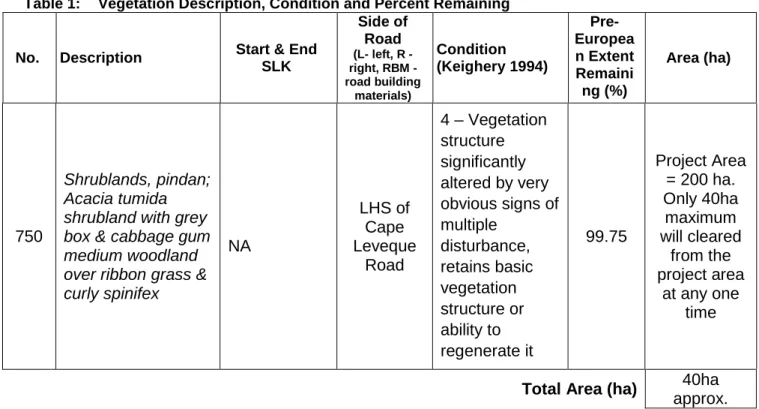The Banana Wells Gravel Pit, located approximately 140 km north of Broome, consists of suitable gravel material for future upgrading works planned for the Broome-Cape Leveque Road. Large sections of gravel were pre-cut or excavated before major roads were required to obtain statutory permission to clear native vegetation. Subject to the material requirements associated with the Broome-Cape Leveque road upgrade works, an area of no more than approximately 40ha will be established annually within the Banana Wells gravel pit.
As one area is excavated and the material is exhausted, it will be rehabilitated before establishing another material recovery area. A search of the Department of Indigenous Affairs' Aboriginal Heritage Inquiry database (Appendix D) did not reveal any significant Aboriginal heritage sites registered in Main Roads is currently consulting with the Kimberley Land Council on the proposed works and all Aboriginal heritage matters will be addressed by the KLC and Traditional Owners to ensure that all aspects of Aboriginal heritage and native title are in accordance with the Aboriginal Heritage Act of in 1972. and the Native Title Act 1993 before any excavation begins.
Environmental assessment of the proposed project was undertaken which determined that clean-up activities associated with the proposal were 'not likely' to contravene the ten clean-up principles (refer to section 5.2). It is not expected that the project will require formal referral to the EPA under the Environmental Protection Act 1986 (EP Act 1986).
BACKGROUND
DESCRIPTION OF THE PROJECT
P ROJECT L OCATION
METHODOLOGY
P RELIMINARY D ESKTOP S TUDY
No further investigations are necessary as the site is outside the high risk area for ASS and no dewatering or excavation below the water table is planned. The need for a local air quality assessment was determined based on the criteria outlined in the MRWA Environmental Guideline, Air Quality.
C OMMONWEALTH R EFERRAL
S TATE R EFERRAL
EXISTING ENVIRONMENT
D ESCRIPTION
CLEARING OF NATIVE VEGETATION
D ETAILS OF V EGETATION A SSOCIATIONS TO BE C LEARED
A SSESSMENT A GAINST C LEARING P RINCIPLES
MAJOR ROADS Western Australia PEIA & EMP for Small Projects 11 of 47. f) Native vegetation should not be cleared if it grows in or is associated with an environment associated with a watercourse or wetland. Any cleared vegetation in the project area will not affect potential communities that rely on wetlands or groundwater. The proposed road design will be. hydrologically neutral and minimizes the impact of vegetation associated with a watercourse.
Native vegetation should not be cleared if the clearing of the vegetation is likely to affect the environmental values of any adjacent or nearby conservation area. The proposal does not conflict with this principle, as the remnants of indigenous vegetation in the project area are not connected to any adjacent or nearby conservation areas. ASSESSMENT It is unlikely that the clearing of remnants of native vegetation would result in a deterioration of surface water quality.
ASSESSMENT The small amount of clearing is not located near any watercourses, it will not affect flooding.
S UMMARY OF M ANAGEMENT A CTIONS
MAIN ROADS Western Australia PEIA & EMP for small projects 13 of 47 Table 3: Summary of additional management actions Impact of clearing Yes/No or. Indicates the assessment that the clearing is in conflict with one or more of the principles for clearing. Does the assessment indicate that the cleaning is contrary to the cleaning principle (g) soil degradation, (i) surface or underground water quality or (j) the occurrence of flooding?
Shall the project involve eviction for purposes considered temporary in nature under Condition 13 of CPS818/6. Yes If the temporary clearing exceeds 0.5 ha, a revegetation plan must be forwarded to the Department of Environment and Conservation prior to clearing.
ASSESSMENT OF ASPECTS AND IMPACTS
Shire of Broome requirements must be met in relation to noise management and construction working hours. Traffic management and signage to main road standards are used, none of the proposed works pose any significant risk to public safety. Not relevant to the proposed works, the project does not require the use of hazardous substances.
Contamination A search of the DEC's database of contaminated sites indicates that there are no identified contaminated sites within the project area. National Heritage Sites A search of the Australian Heritage Sites Inventory database indicated that there are no heritage significant listed sites present in the proposed work areas. A search of the Department of Sustainability, Environment, Water, Population and Communities Search Tool for Protected Matters did not find any Ramsar wetlands in the vicinity of the Project Area.
An investigation by the Department of Sustainability, Environment, Water, Population and Protected Affairs found no endangered ecological communities near the project, 7 threatened species and 13 listed marine species in the search tool. A Department of Sustainability, Environment, Water, Population and Protected Affairs search tool found 15 migratory species near the project site.

DECISION TO REFER
R EFERRAL TO THE D EPARTMENT OF S USTAINABILITY , E NVIRONMENT , W ATER ,
R EFERRAL TO THE E NVIRONMENTAL P ROTECTION A UTHORITY
STAKEHOLDER CONSULTATION
OTHER APPROVALS/PERMITS/LICENCES
ENVIRONMENTAL MANAGEMENT PLAN
Ensure that overall work objectives are compatible with maintenance and, where possible, This vegetation will be used during any remedial works and will either be cleared or replaced in accordance with the EMP. Where vegetation clearance has occurred, re-vegetation will be incorporated into restoration works in accordance with the re-vegetation management plan developed prior to clearance and to ensure compliance with CPS 818/6 and the Aboriginal Heritage Act 1972.
Control all weed species, if present, in the project area prior to works to limit the amount of propagating material that can spread during disturbance. Areas subject to erosion due to clearing shall be stabilized and designed to minimize rainfall/runoff impacts. If leaching or chemical storage facilities are in progress at the site, best management practices will be used in accordance with the DEC Water Quality Protection Mechanical Notes.
Access to private property and appropriate traffic management measures should be planned and implemented prior to the start of work. Ensure that work is managed to a standard that minimizes any negative impacts on the environment. Bulk fuels and oil stocks will be bundled and managed in accordance with Australian standards.
All waste oil will be collected for recycling and any empty fuel/oil containers, used filters and remaining hydraulic parts will be collected and stored in a designated area and then removed to one. A water tanker will be in place at all times No fires will be lit within the project area. If any material of significance to Aboriginal people is discovered, work will cease immediately within 100m of the material and the site will be examined by a qualified archaeologist.
During works, access to historical records, information regarding previous operations, land definitions and so on will enable the appropriate management for rehabilitation of the area, to make it aware of any hazards or areas of significance or sensitivity and for general management. These records should be updated as work progresses and ceases, and monitored for future reference. These records and information must be managed in a way that is easily accessible, easy to understand and easy to communicate.
SITE PHOTOS

